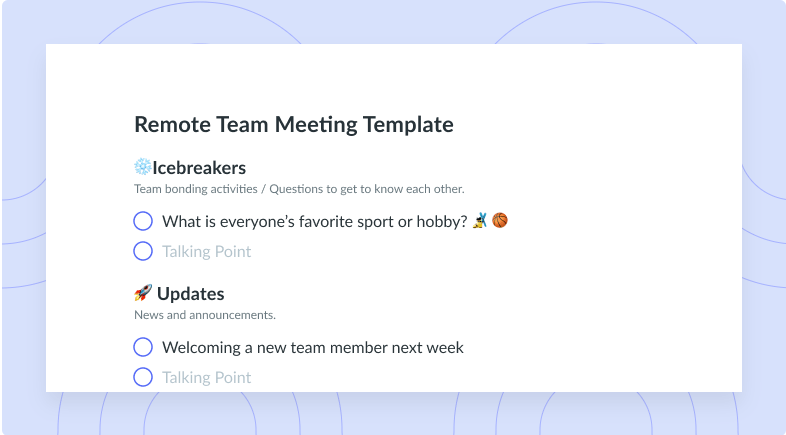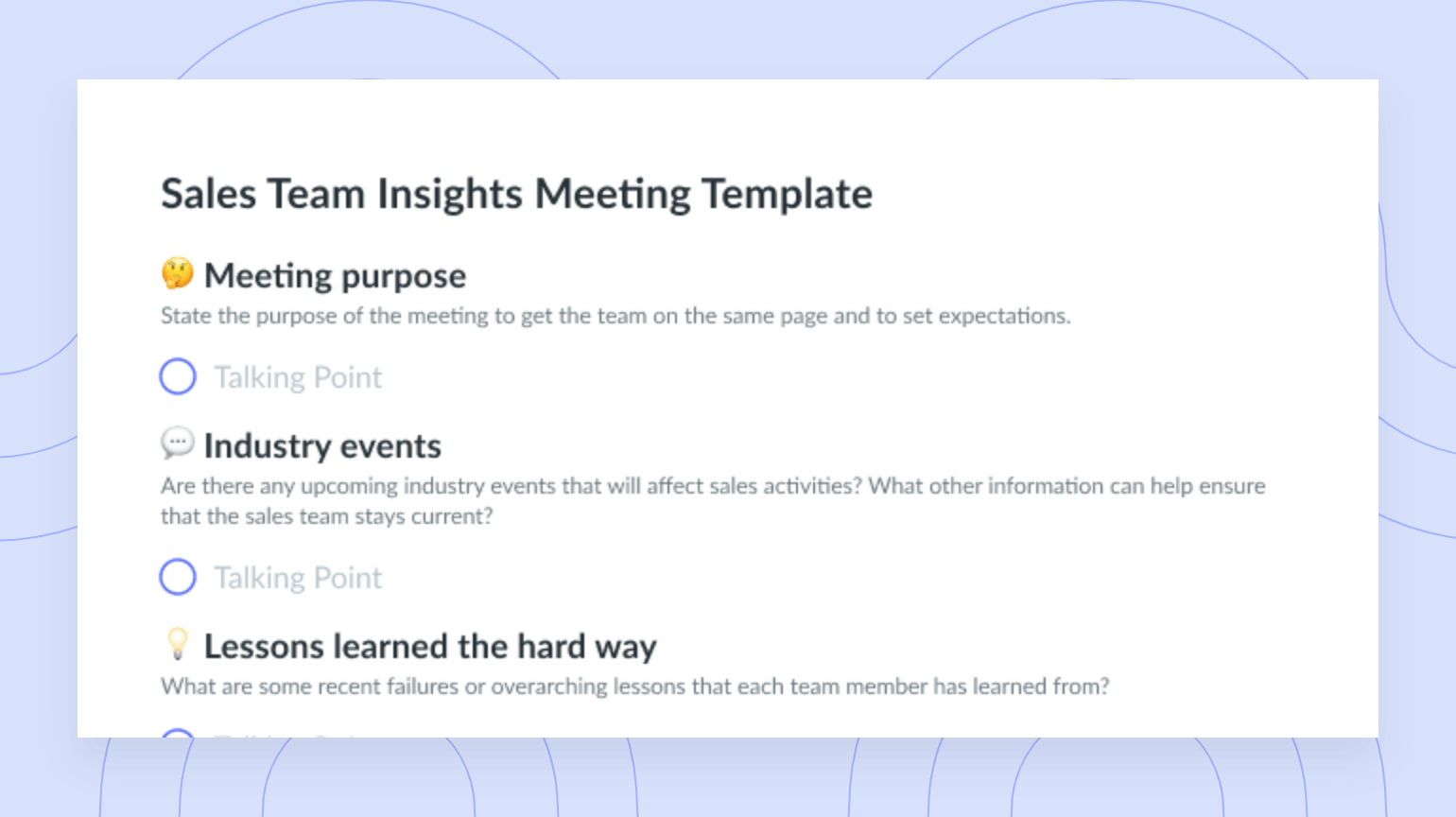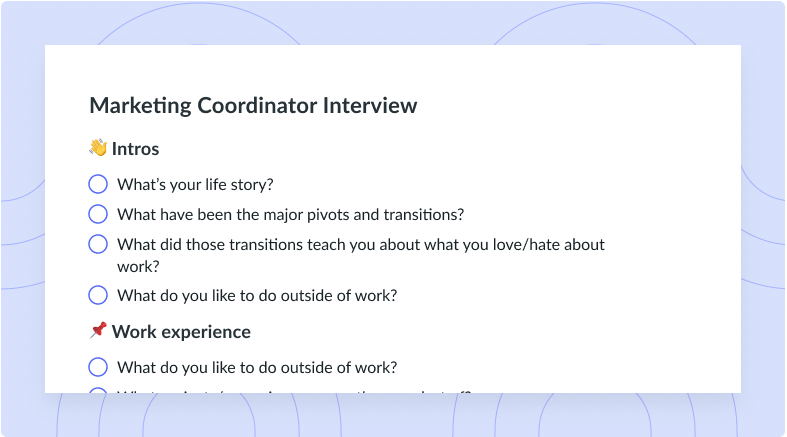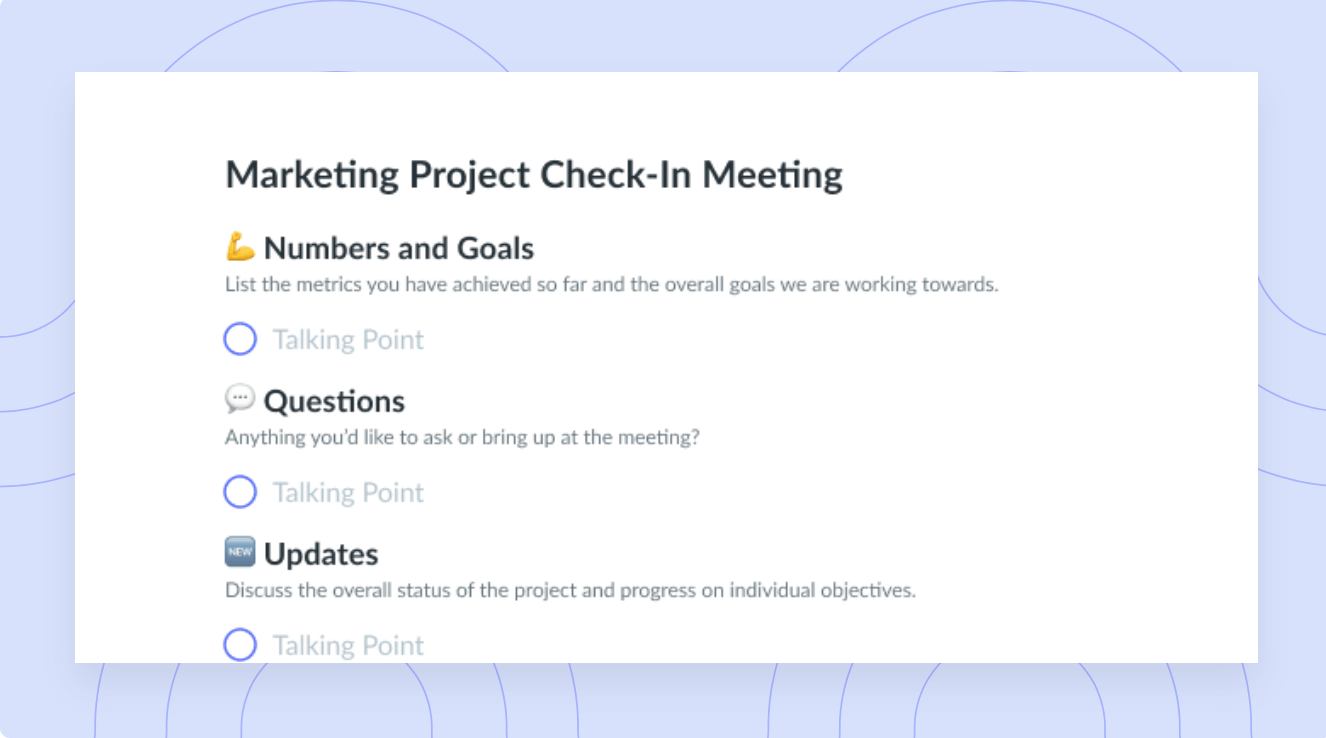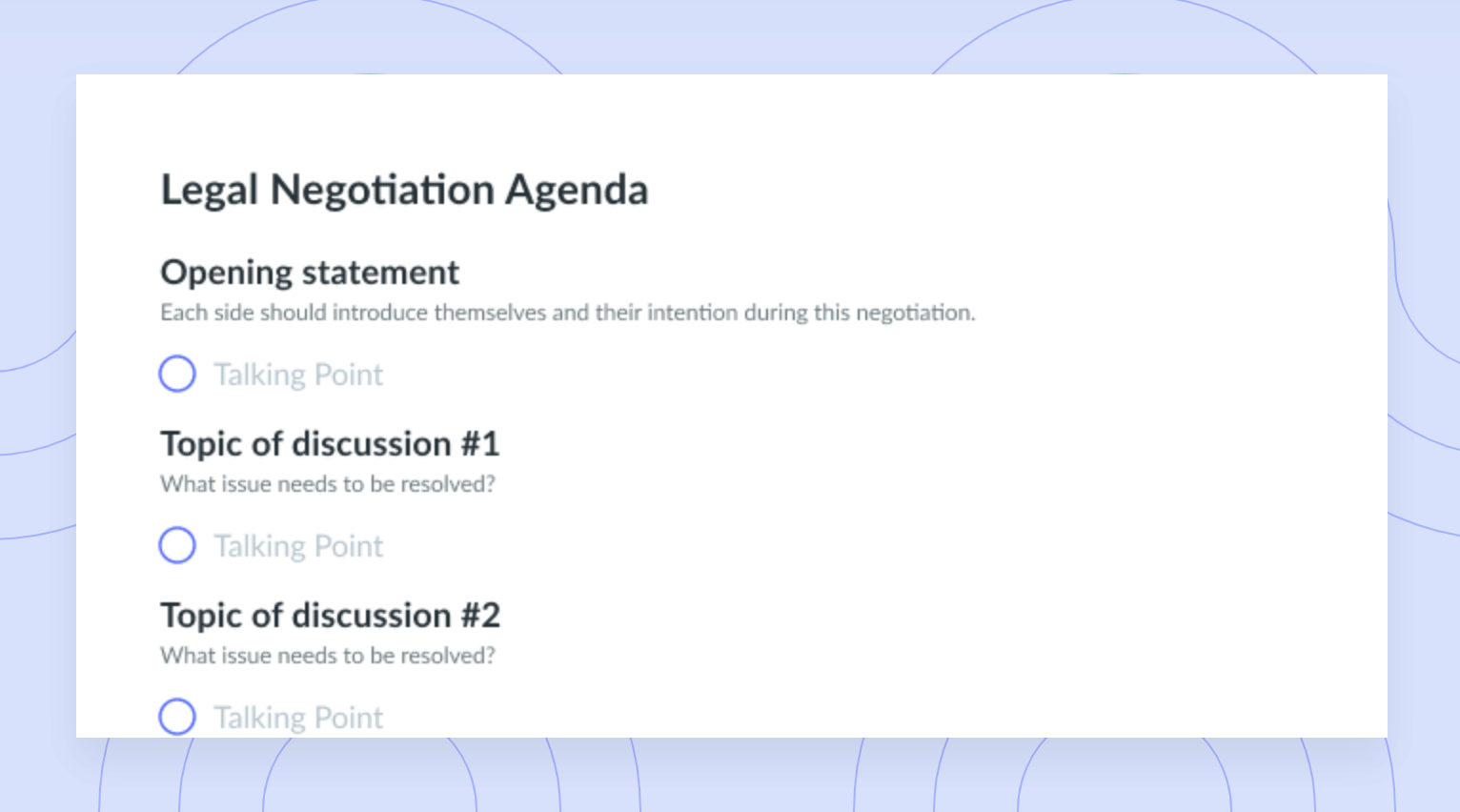8 Best Practices for Leading Effective Team Meetings
The best advice from world-class managers on how to run productive team meetings.
Think of all the bad team meetings you have attended: Meetings where one person dominated the conversation, the room argued in circles, or the content shared was repetitive – and could have easily been an email.
Running an effective team meeting shouldn’t be rocket science. However, most managers are still running team meetings that are poorly organized, overly long, and lack clear takeaways.
If you’re wondering how you can make your team meetings more productive, this post is for you.
Here are 8 actionable tips to run team meetings that are both helpful and effective:
- Create a meeting agenda
- Bring all voices into the conversation
- Respect people’s time
- Take a moment to recognize employees
- Ask about roadblocks and concerns
- Assign clear action items and takeaways
- Share the meeting notes with all attendees
- Ask team members for feedback
- Free Meeting Template
1 Create a meeting agenda and encourage everyone to prepare ahead of time
You can’t have an effective team meeting unless all the attendees are prepared to contribute to the conversation.
Start by creating a shared meeting agenda that is visible and editable by everyone on the team. This will give all attendees an equal chance to prepare and contribute.
“Sending out an agenda ahead of time shows a level of care and intentionality in helping the group stay focused,” says Julie Zhuo, author of The Making of a Manager. “It’s a good idea to do this for meetings of any size, even 1:1s, but the larger the meeting, the more important the preparation.”
Keith Rabois, a General Partner at Founders Fund and the former COO of Square, shares a similar argument in the essay How to be an Effective Executive.
Rabois argues that spending time preparing for large meetings is one of the most important things you can do as a leader, since those meetings are the ideal scenario to communicate ideas and impact how everyone on your team makes decisions:
“When you have many people affected by one thing, spending a lot of time to perfect it is high leverage,” says Rabois. “Agendas across all meetings should be set and sent ahead of time.”
Collaborating on a meeting agenda won’t just make all your meetings more productive. According to Kathryn Heath and Brenda Wensil, it will also be the first step towards building a more inclusive company culture, where everyone’s ideas and contributions are valued:
“Meetings matter. They are the forum where people come together to discuss ideas, make decisions, and be heard. Meetings are where culture forms, grows, and takes hold. So it stands to reason that if an organization desires a more inclusive culture — and leaders want to model inclusion — then meetings are the place to start.”

Productivity Tip
Use one of Fellow’s pre-built templates to save time and spark ideas for your next meeting. Already have a favourite way to run your meeting? Build your own template, save it for later, and ditch the stress of creating an agenda from scratch.

2 Bring all voices into the conversation
“The role of the conductor in an orchestra is to manage the tempo of a performance. They listen critically to keep musicians playing in unison and actively control the dynamic to prevent one instrument from overpowering the rest. The same goes for leaders in meetings — you need to manage conduct and give everyone space to play their part,” say Heath and Wensil.
One of the most important practices you can adopt as a leader is stepping in when there are one or two individuals dominating the conversation. Make it a habit to:
- Go around the room and ask the quieter members of the team for their opinion.
- Be on the lookout for interruptions. If someone gets cut off, provide cover by saying “Hang on, <Name> wasn’t finished.”
- Foster a welcoming environment by repeating that everyone’s input matters and there are no ‘stupid’ ideas or questions.
- Before a brainstorming session, ask people to write down their ideas and stick them on the wall before talking through each of them.
“If you are a meeting organizer trying to generate ideas, make a decision, or create stronger relationships, you will get better results if you can get your entire group to contribute,” says Julie Zhuo.
3 Respect people’s time
In the book High Output Management, Andy Grove argues that wasting employee’s time is the equivalent of stealing from your company 💰. The comparison might sound a little harsh, but it’s a good way to explain that gathering a group of employees in the same room represents a big cost – and should only be done when it will boost your team’s productivity:
“Just as you would not permit a fellow employee to steal a piece of office equipment worth $2000, you shouldn’t let anyone walk away with the time of his fellow teammates,” says Grove.
Creating a meeting agenda is the first step towards showing respect for your teammate’s time. It will help you stay focused on the meeting’s purpose and avoid digressions.
The second step is emphasizing the importance of punctuality ⏰. If one person tends to be late for your team meetings, you can give them some feedback during your one-on-one.
Finally, respecting people’s time involves acknowledging when a meeting should be cancelled or cut short. Some reasons why you might want to finish early or cancel that week’s meeting include:
- Most of the team is out or on vacation.
- You checked off all the talking points in the meeting agenda.
- The team could use the time to work on an upcoming deadline.
4 Take a moment to recognize employees
Great managers praise in public and criticize in private. That’s why another practice you should adopt as a leader is taking a moment to recognize employees during your team meetings.
“Public praise tends to lend more weight on the praise, and it encourages others to emulate whatever was great,” says Kim Scott, author of Radical Candor.
Here are two things to consider if you’re thinking about praising a teammate publicly:
- Adapt to people’s individual preferences. While the majority of people like to be praised in public, some people might dislike public mentions. You should ask employees if they like public recognition during one of your one-on-one meetings.
- You don’t have to be the only one recognizing people. One more thing you can do is add a Feedback/Shoutouts section in your meeting agenda. This is a great way to encourage other employees to recognize their teammates.
5 Ask about roadblocks and concerns
In a study titled The Iceberg of Ignorance, Sidney Yoshida concluded that only 4% of an organization’s front-line problems are known by top management. In order to prevent this, you can use one-on-ones and team meetings to ask your teammates about the blockers that might be impeding them from doing their work.
“Roadblocks include policies, practices, tools and sometimes personal behaviors which keep employees from performing their work in the most productive fashion,” say business consultants Doug and Polly White. “The ability to remove such roadblocks for your own employees is one of the most powerful tools a manager can wield.”
6 Assign clear action items and takeaways
Action items are arguably the most important components of your team meeting. They’re an essential part of making sure that your meetings involve new discussions, ideas, and decisions – and aren’t just scheduled to exchange updates.
“After the meeting, the follow-ups need to be treated with as much care as the preparation,” says Julie Zhuo. “A single meeting is not an end unto itself; it is a stepping-stone in the much longer path of creating something valuable for the world.”
What’s the best way to record action items from your team meetings?
We recommend writing them at the bottom of your meeting agenda and assigning them as the meeting evolves. This will allow you to go back and reinforce what the team agreed on at the end of each meeting. Using a meeting agenda app can help you and your team build this habit.
3 tips to write clear and impactful action items:
- Start with a verb.
- Be specific – imagine you’re writing for someone else.
- Assign ownership of the task.
7 Share the meeting notes with all attendees
In the book Resilient Management, Lara Hogan argues that sending out a recap email after each meeting is a great way to reinforce decisions, clarify company messages, and address your teammates’ frustrations:
“I love the practice of repeating decisions or actions after a meeting with a recap email,” says Hogan. “This communication method harnesses all of email’s power for good: it helps set the record straight, disseminates information to lots of people at once, and opens up conversation internally, while reflecting on the themes that have come up for you in weekly 1:1s, backchannels, team meetings, etc.”
For weekly team meetings, sending an email with the meeting notes and agreed action items might be enough. It will be a good reminder of the things that were discussed and the takeaways that the team agreed on.
However, writing a personal message to accompany those notes is especially important after meetings where you made an important announcement, talked about a controversial decision, or felt that the team morale was low.
As Andy Grove, author of the book High Output Management argues, sending your meeting minutes is the final step to having productive conversations:
“All this may seem like too much trouble, but if the meeting was worth calling in the first place, the work needed to produce the minutes is a small additional investment (an activity with high leverage) to ensure that the full benefit is obtained from what was done,” says Grove.
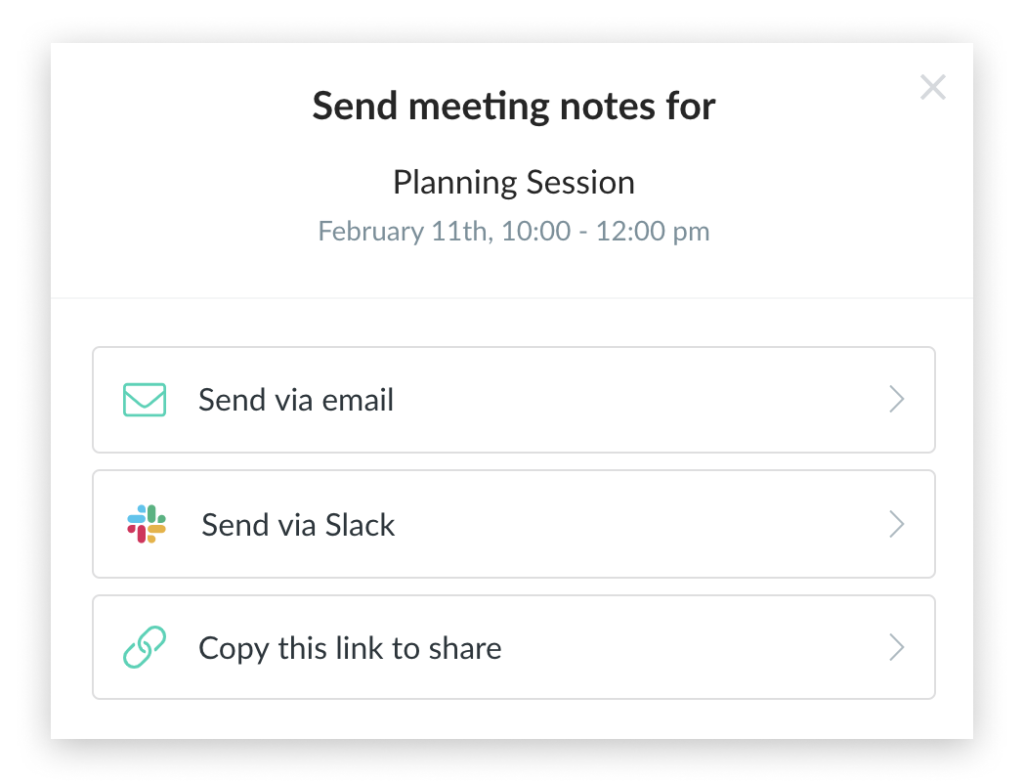
8 Ask team members for feedback about the meeting
When was the last time you asked employees for feedback about your team meetings?
In The Making of a Manager, Julie Zhuo describes a time when one of her reports let her know that their weekly “stand-up” meeting could easily be an email:
“Gutsy move, telling your manager that her meeting sucks,” says Zhuo. “But the feedback was spot-on. I left with a deeper appreciation of both the importance of planning good meetings and the value of giving feedback to improve bad meetings.
Some questions you can ask to improve your team meetings:
- Should this meeting be shorter?
- How can we make this meeting more effective?
- What’s your favourite part about this meeting?
Pro Tip
Make it a habit to ask for feedback about your meetings on a quarterly basis. Giving employees the opportunity to express their opinion will help you develop an inclusive culture and ensure that all your meetings are useful.
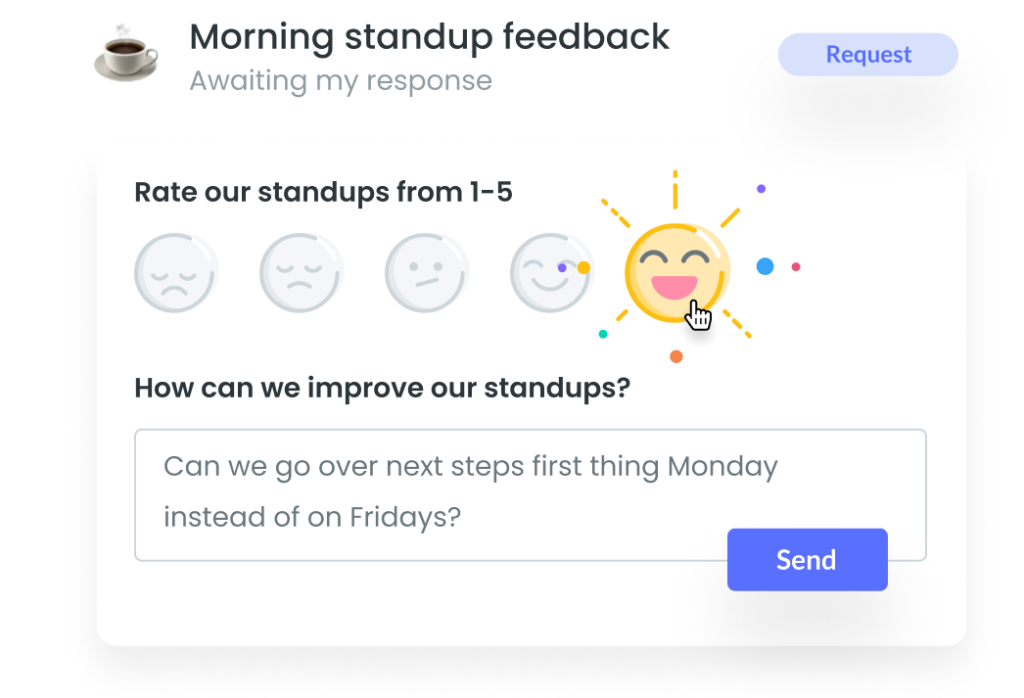
Free Meeting Template
Try these specifically crafted agenda templates for remote and distributed team meetings!

About Fellow.app
Meetings being booked without a purpose or going completely off-topic? Fellow’s collaborative approach transforms meetings into productive work sessions you’ll want to attend. Try it for free – your team will thank you 😉


![How to Run an Effective Weekly Team Meeting [Free Agenda Templates]](https://fellow.app/wp-content/uploads/2019/10/Weekly-Team-Meeting-Agenda-Template.jpg)







